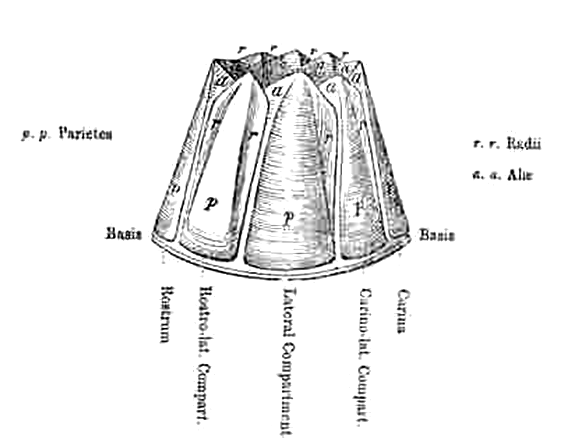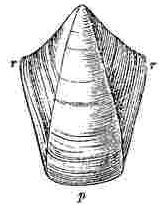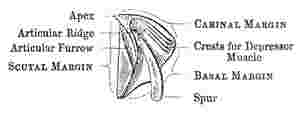
My former volume, published by the Ray Society, treated only of the Lepadidæ, one family of the Cirripedia: I was induced to print it from having the materials ready, though this partial publication has been in some respects inconvenient. The Palæontographical Society has done me the honour to publish, with ample illustrations, the fossil species of this same family of Lepadidæ. This present volume completes my work on the sub-class Cirripedia. I had originally intended to have published a small volume on my anatomical observations; but the full abstract given in my former volume, which will be illustrated to a certain extent in the plates appended to this volume, together with the observations here given under the Balanidæ, appear to me sufficient, and I am unwilling to spend more time on the subject. In the volume on the Lepadidæ, I gave the specific or diagnostic characters in English and Latin: I have here left out the latter, inasmuch as I have appended at the end of this volume a Latin Synopsis of all the species, recent and fossil, of the whole class. To each species is added a reference to the pages and plates of my three volumes, so that the Synopsis will serve as a systematic index to the three: an alphabetical index to the present volume is also given. In the Lepadidæ, I gave an additional specific character, derived from the softer parts of the animal’s body: in the Balanidæ, these parts are more alike in the different species, and I have found it impossible to give a diagnostic character thus derived. In those cases in which a Family contains but one genus, or a Genus but one species, I have assigned my reasons for the institution of such groups, but have given, as heretofore, only a single description in full: it would have been easy to have separated, by analogy, this description into one for the species, another for the genus or for the family; but as I believe such separation and subordination of the characters would have been largely conjectural, I have thought it best to act as I have done, and give, thus saving useless repetitions, only a single description, and leave it for my successors, when more genera or species are known, to separate, with such certainty as is ever possible, the generic from the specific characters.
The number of the British fossil species of the Balanidæ and Verrucidæ in a recognisable state is so small, that I do not know whether it will be considered worth while to publish in the Palæontographical series more detailed illustrations than are given in this volume.
In nomenclature, I have endeavoured rigorously to follow the rules of the British Association, and have never, at least intentionally, broken through the great law of priority. In accordance with the rules, I have rejected, that is, as compulsory, all names given before the introduction of the binomial system in 1758. I have given much fewer synonyms than is usual in conchological works; for it is impossible to recognise with any approach to certainty, several even of the common European forms, in the short descriptions given by most authors; this holds good in many cases in which figures, in appearance excellent, have been added. I assert this the more confidently, from having had the advantage of having gone over some of the Linnean synonyms with Mr. S. Hanley. I may further venture to express my conviction, that giving references to works, in which there is not any original matter, or in which the plates are not of a high order of excellence, is absolutely injurious to the progress of natural history.
NOMENCLATURE OF THE SHELL OF A SESSILE CIRRIPEDE.
SHELL. Fig. 1.
Orifice of shell, surrounded by the sheath. Sheath formed by the alæ (a — a.) and by portions of the upper and inner surfaces of the parietes (p — p.)

N.B. In Balanus, and many other genera, the Rostrum and Rostro-lateral compartments are confluent, and hence the Rostrum has the structure of Fig. 2.
Fig. 2.

Fig. 4.

Fig. 2. Compartment with two radii, serving either as a Rostrum or Rostro-lateral compartment.
Fig. 3. serves as a Lateral and Carino-lateral Compartment.
Fig. 4. serves as a Carina or Rostrum.
Fig. 5. SCUTUM (internal view of).
Fig. 6. TERGUM (external view).
Fig. 7. TERGUM (internal view).

Sessile Cirripedes, partly from being attached to surfaces having very different characters, partly from undergoing a varying amount of disintegration, and partly from unknown innate causes, are extremely variable. Under the head of Variation, in the Family Balanidæ and under the Genus Balanus, I have enlarged on this subject, and have shown that there is scarcely a single external character which is not highly variable in most of the species. As whole groups of specimens often vary in exactly the same manner, it is not easy to exaggerate the difficulty of discriminating species and varieties. It is absolutely necessary in most cases, for mere identification, that the valves of at least one specimen in a group should be disarticulated and well cleaned (for which purpose caustic potash is most useful), so that the internal characters may be examined. Whoever attempts to make out from external characters alone, without disarticulating the valves, the species, (even those inhabiting one very confined region, for instance the shores of Great Britain,) will almost certainly fall into many errors: hence it is, and can thus only be accounted for, that I have not seen one collection of British specimens with all the species, though so few in number, rightly discriminated; and in the large majority of cases, either two or three species, certainly distinct, were confounded together, or two or three varieties, as certainly not distinct, were separated from each other.